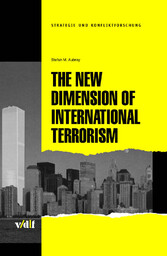Suchen und Finden
Service
The New Dimensions of International Terrorism
Stefan Aubrey
Verlag vdf Hochschulverlag AG, 2004
ISBN 9783728129499 , 321 Seiten
Format PDF, OL
Kopierschutz DRM
Geräte
Table of Contents
6
Chapter One Introduction
8
Introduction
8
Chapter Two Hypothesis
12
2.1 The New Dimension of International Terrorism (H)
12
2.2 The Role of Ideology in the New Dimension of International Terrorism (H¹)
12
2.3 The Asymmetrical Component of the New Dimension of International Terrorism (H²)
13
2.4 Combating the New Dimension in International Terrorism (H³)
15
Notes
16
Chapter Three Definitions of Terrorism
18
Terrorism
19
Terrorist
19
Notes
26
Chapter Four The History of Terrorism
28
4.1 Early Terrorist Organizations and Movements.
28
4.2 19th Century Philosophers of Terrorism.
30
4.3 From Philosophy into Action – A Four Phase Model
31
4.4 The Internationalization of Terrorism
39
4.5 The Munich Olympic Games Massacre of 1972
41
4.6 Western European Terrorist Groups
43
4.6.1 West German Red Army Faction
44
4.6.2 The Italian Red Brigades (
46
4.7 ETA and the IRA
47
Notes
48
Chapter Five Typologies of Terrorism
50
5.1 Nationalist Terrorism
50
5.2 Religious/Cultural Terrorism
51
5.3 State Sponsored Terrorism
51
5.4 Left Wing Terrorism
51
5.5 Right Wing Terrorism
52
5.6 Anarchist Terrorism
53
Notes
53
Chapter Six Current International Terrorist Groups
54
6.1 Al-Qaeda
54
6.2 Palestinian Islamic Jihad
55
6.3 Hamas (Islamic Resistance Movement)
55
6.4 Hizballah (Party of God)
56
6.5 17 November (Revolutionary Organization 17 November)
57
6.6 Abu Sayyaf Group (ASG)
57
6.7 Jemaah Islamiyah (JI)
58
6.8 Armed Islamic Group – Algerian GIA
58
Notes
59
Chapter Seven Political Islam
60
7.1 The Bridge to a New Dimension of International Terrorism
60
7.2 Political Islam and Islamic Jihadist Terrorism
64
7.2.1 A Historical Perspective
67
7.2.3 The Increasing Role of Islamic Consciousness
71
7.2.4 The Islamic Threat: Myth or Reality
74
7.2.4.1 Islamic resurgence and the contemporary revival of Islam
77
7.2.4.2 The significance of the Iranian Revolution
79
7.2.4.3 The historical legacy of the Islamic Community
80
7.2.4.4 Islamic Law
82
7.2.4.5 Branches of Islam
83
7.2.4.6 Modern Islamic Revivalist Movements
85
7.2.4.7 Egypt’s experience with Islamist revivalism
86
7.2.4.8 Islam, Nationalism and the State – Iran
89
7.2.4.9 The Muslim Brotherhood and the Jamaat-i-Islami
94
7.2.4.10 Radical Islam
95
7.2.4.11 Islam and the West
97
7.2.4.12 The Underestimation of Islamic revivalism
98
7.2.5 Wahhabism as a Vehicle to Export Terrorism
100
7.2.6 The Saudi Arabian Role in the New Dimension Terrorism.
102
7.2.7 Saudi Arabia and Extremist Ideologies of Islam
104
7.2.7.1 External Influences
105
7.2.7.2 Violent Islamic opposition to the Saudi Arabian regime
108
7.2.7.3 Militant Islamic opposition to the Saudi Arabian regime
108
7.2.7.4 Militant Extremism in Saudi Arabia: Osama bin Laden and Al Qaeda
110
7.2.8 Motivations for Terrorism related to the Middle East
111
7.2.9 The Role of Iran and Hizballah
113
7.2.10 The Israeli perspective on Hizballah
115
7.2.11 The Concept of
118
7.2.12 Osama bin Laden, Al Qaeda and the new Transnational Jihad
123
7.3 Failed States as the Safe-haven
124
7.3.1 The Afghanistan and the Taliban/al-Qaeda Connection
126
7.3.2 Pakistan’s contribution to Islamist Radicalism
130
7.3.3 Osama bin Laden’s Sudan Connection
132
7.3.4 Algeria
133
7.3.5 Somalia and Al-Qaeda
136
7.3.6 Yemen
138
7.3.7 Chechnya and the Vulnerable Underbelly of Russia’s “Near Abroad”
139
7.3.7 Central Asia
142
7.3.9 Why Terrorist Networks Need Failed States
144
Notes
146
Chapter Eight Al- Qaeda
152
8.1 The Development of al-Qaeda
152
8.1.1 The Background of Osama bin Laden
154
8.1.2 Structure, Ideology, and Strategy 8.1.2.1 Structure and Organization for Combat
159
8.1.2.2 Ideology
162
8.1.2.3 Al-Qaeda Training
164
8.1.2.4 Al-Qaeda Tactics
166
8.2 Al-Qaeda’s War Aims
167
8.2.1 Political War Aims
168
8.2.2 Religious/Cultural War Aims
168
8.2.3 Economic War Aims
169
8.2.4 Military War Aims
169
8.3 Interim Objectives of al-Qaeda
169
8.4 Ramzi Yousef and the New Jackals
171
8.5 The Attacks of Al-Qaeda
177
8.5.1 The Bombing of the US Embassies in East African
181
8.5.2 The USS Cole attack
185
8.5.3 The 9-11 Attacks
187
8.6 The Al-Qaeda Global Network
194
8.6.1 The North American Connection
195
8.6.2 The European Connection
196
8.6.3 The Middle Eastern Connection
204
8.6.4 Al-Qaeda’s Southeast Asian Network
207
8.7 Al-Qaeda – the Potential for Future Risks
212
8.8 The Permutation and Franchising of Al-Qaeda
220
Notes
222
Chapter Nine The Financing of the New Dimension of International Terrorism
230
9.1 Financing the New Dimension of Terrorism and the Terrorism-Crime Nexus
230
9.1.1 A Financial Analysis of Al-Qaeda as a Terrorist Network
231
9.1.2 Saudi Banking, Charities and Al-Qaeda
236
9.2 The Crime-Terrorism Nexus
241
9.2.1 Al-Qaeda and the Opium Connection
245
9.3 U.S. Efforts to Stem the Flow of Al-Qaeda’s Financing
247
Notes
249
Chapter Ten Hypothesis Validation
252
10.1 H¹ – The Role of Ideology in the New Dimension of International Terrorism
254
10.2 H² – The Asymmetrical Component of the New Dimension of International Terrorism
256
10.3 H ³ – The Challenges of Combating the New Dimension of International Terrorism
267
10.4 The Validation of the Hypothesis H¹+ H²+ H³ = H
269
Notes
270
Chapter Eleven Combating the New Dimension of International Terrorism
272
11.1 U.S. Counterterrorism Policy and Strategy
272
11.2 Congressional Inquiry into the 9-11 Attacks
278
11.3 Combating Al-Qaeda
279
11.4 Taking out the Key Leadership
284
11.5 Eliminating Safe Havens for Terrorism
287
11.6 Combating Terrorist Financing
292
11.7 Middle East Issues Impacting on the War on Terrorism
293
11.8 Maintaining the Strategic Focus in the War Against Terrorism – Some Suggested Alternatives to Combating International Terrorism
296
Notes
303
Chapter Twelve Conclusion
306
Notes
307
Bibliography
308
Service
Shop


















